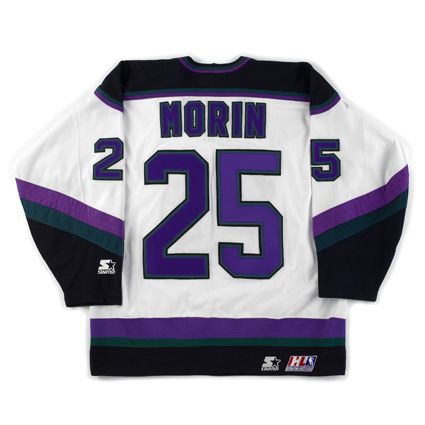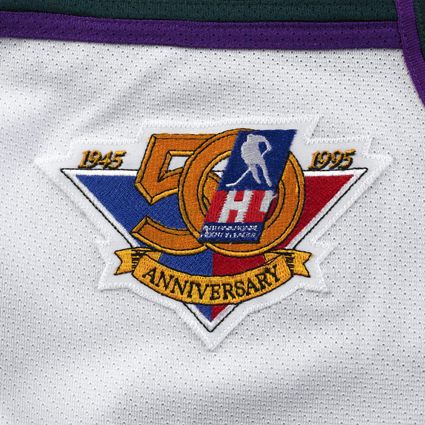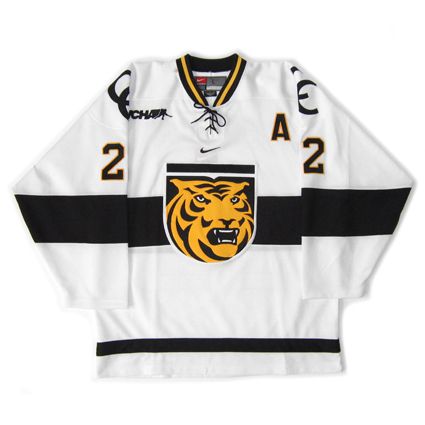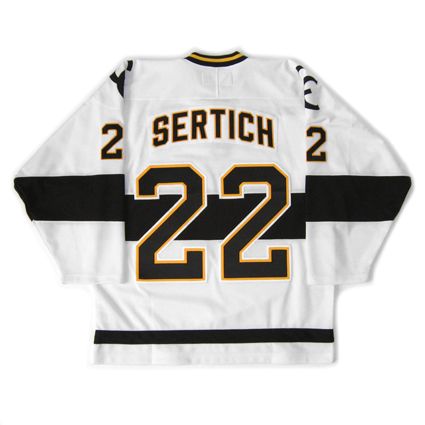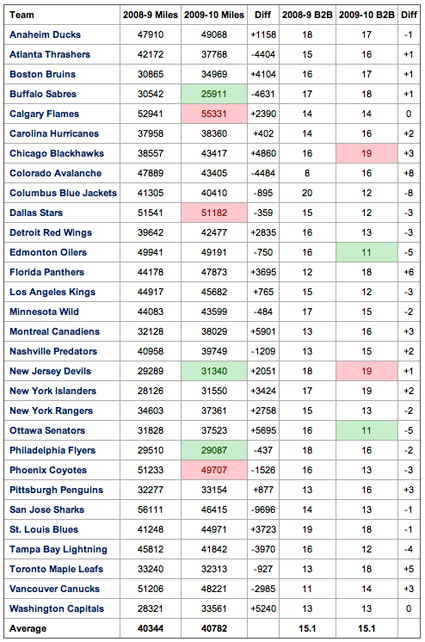Saturday, July 25, 2009
1994-95 Minnesota Moose Stephane Morin Jersey
July by the Numbers reaches #25 as we head north to Minnesota.
While the Minnesota Moose only played two seasons in St. Paul, Minnesota after the departure of the NHL's North Stars for Dallas, they provided some exciting hockey, generally of the rougher kind typical of the International Hockey League in those days, and one wildly successful logo, which was ranked #1 in a poll by The Hockey News and led all minor league teams in terms of merchandise sales.
One of the highlights for the Moose during their first season in the old St. Paul Civic Center was undoubtedly the play of Stephane Morin, who scored 33 goals and a 81 assists, nearly double the next closest on the roster, for 114 points to win the league scoring title to capture the Leo Lamoureux Memorial Trophy.
Other players to suit up for the Moose in Minnesota were Dave Christian, who set the team record for goals in a season with 38 and whose Moose road jersey was featured earlier here at Third String Goalie, team captain and current University of North Dakota head coach Dave Hakstol, all-time team penalty minute leader Brad Miller, former Red Wing and 16 year NHL veteran Reed Larson, the first North American to play in Russia Tod Harjte, whose memoir of his experience "From Behind the Red Line" can be purchased here (six used copies for a PENNY at the time of this writing!), former NHLers goaltender Tom Draper, Stew Gavin, Gordie Roberts and last but not least, the unfortunately named goaltender Parris Duffus.
Today's featured jersey is a Starter 1994-95 Minnesota Moose Stephane Morin home jersey which features the IHL 50th Anniversary patch worn during the Moose's first season when Morin won the IHL scoring title.
While the three color combination of purple, forest green and black was a questionable choice at best on the black road jerseys, it does come across slightly better on the home white jerseys, but not by much. While the separation of the green from the purple and black is marginal for the larger numbers, it really becomes a dark mass when reduced in size for the name on the back.
While the back of the jersey has it's flaws, the front of the jersey is a winner, with the popular Moose logo and the added shot of color from the IHL anniversary patch.
Here's some rare non-fighting clips of the Moose in action.
It's back to business as usual with the fisticuffs, but another rarity, the Moose in action at the St. Paul Civic center after the famous clear boards had finally been replaced due to age and the advent of dasherboard advertising rendering them ineffective.
For comparison, here's a WHA Fighting Saints highlight package with some road games with the usual boards and some home game action with the unmistakable clear boards.
Labels:
IHL,
Minnesota Moose,
Morin Stephane
Friday, July 24, 2009
2001-02 Houston Aeros Alternate Stephane Veilleux Jersey
July by the Numbers heads down to the Lone Star State for stop #24 today.
The Houston Aeros of the old World Hockey Association began play in 1972 and would go on to win four regular season titles, four Division championships and a pair of Avco World Trophies as champions of the WHA behind the Howe family, legendary Gordie and sons Mark and Marty. The Aeros final season would be 1977-78.
Fast-forward to 1994 when the International Hockey League would expand and the new Houston franchise would adopt the Aeros name in honor of the original WHA club, the second such team named after a WHA team, following the Phoenix Roadrunners.
The Aeros would play seven seasons in the IHL, winning the championship and the Turner Cup in 1999. When the IHL folded in 2001 the Aeros were one of six teams to join the American Hockey League, where they would win an AHL championship, claiming the Calder Cup in 2003, joining the Chicago Wolves as the only two teams to win both the Turner Cup and the Calder Cup.
Today's featured jersey is a 2001-02 Houston Aeros alternate Stephane Veilleux jersey. This jerseys primary logo is the "A" taken from the Aeros wordmark. The team's primary logo, it's ever-popular bomber logo, is used as the secondary logo on the shoulders in this case.
This style jersey was worn for only one season, as the Aeros would traditionally introduce a new alternate each season. The back numbers are the first example of kiss-cut lettering I became aware of. Instead of smaller white numbers being sewn on top of a larger blue layer to create two color numbers, a narrow blue outline layer (which is open in the center to allow the base color to show through) is sewn on top of a full size white layer to create the two color number effect.
My jersey also features the custom made "Whataburger" sponsorship patch created with my transfer process to give it an extra look of authenticity.
Veilleux played four seasons for the Aeros, including leading the team in playoff scoring during their 2003 Calder Cup championship run, and parts of six seasons for the Minnesota Wild, with a high of 18 points in both of the previous two seasons. He recently signed a free agent contract with the Tampa Bay Lightning, ending his time in Minnesota. He once totaled 115 points in a season for the Val-d'Or Foreurs of the QMJHL.
Labels:
Houston Aeros,
IHL,
Veilleux Stephane
Thursday, July 23, 2009
1987-88 Minnesota North Stars Brian Bellows Jersey
July by the Numbers stops at #23 today with a classic jersey from the days of the Met Center and a look at Mariucci Arena, both old and new.
The Minnesota North Stars came to be in the great NHL expansion of 1967. Their familiar green and gold jerseys kept adding more and more gold as time went on, in the form of wider trim and drop shadowed numbers, followed by even wider stripes that would equal the width of the once dominant green stripes. Once the gold reached it's peak, black began to be added to the mix, first on the home jerseys in 1981 and then later on the road jerseys in 1988, until the unfortunate black coup in 1991, as the entire look was revamped, giving birth to some of the most generic jerseys lacking in personality of the otherwise classic early 90's NHL.
Brian Bellows was drafted second overall by Minnesota in 1982 after the North Stars made a trade to move up with selecting Bellows in mind. He would play ten seasons in Minnesota, making it to the Stanley Cup Finals once in 1991 and appear in three All-Star Games, 1984, 1988 and 1992. His best offensive season was in 1989-90, when he scored a career high 55 goals and 44 assists for 99 points.
In 1992 he was traded to the Montreal Canadiens, where he would play three seasons and capture his only Stanley Cup in 1993. The later years of his career would see him move from the Tampa Bay Lightning to the Mighty Ducks of Anaheim, and both the Berlin Capitals in the German DEL, and the Washington Capitals of the NHL, with whom he would return to the Stanley Cup Finals in 1998.
During his second season in Washington, he would score his 1000th point, becoming the 54th player to reach that milestone.
The jersey I am featuring today is a 1987-88 Minnesota North Star Brian Bellows jersey. This jersey is from the last season before black was finally added to the road jerseys, seven years after being added to the home jerseys.
This jersey features the "JM" patch worn in honor of John Mariucci, "The Godfather of American Hockey". He played for the University of Minnesota, played five seasons for the Chicago Blackhawks when American players in the NHL was a rarity, and then spent four more seasons playing in the various minor leagues of the day before retiring and entering the world of coaching.
Mariucci coached the University of Minnesota for 12 seasons with another spent as the coach of the US Olympic team, earning a silver medal in 1956. He would also coach Team USA at the 1976 and 1977 World Championships. The home of the Minnesota Golden Gophers, Mariucci Arena, is named for John and he is a member of the United States Hockey Hall of Fame and the Hockey Hall of Fame.
Here's a very well spoken rookie Brian Bellows taking between periods of a game, apparently just after getting into a scrap with none other than ESPN's Barry Melrose.
And this may very well be that scrap.
I usually go out of my way to avoid posting "slide shows" from YouTube to provide you with the best quality material possible, but sometimes exceptions have to be made, as in this case to honor John Mariucci and the two arenas the Gophers have played in named for him.
Don't miss the shots of the interior of the original Mariucci arena, especially the overhanging sloped ceiling over the south end of the arena, where high shots and deflected pucks would rebound violently downward rather than sailing over the glass as they would at any normal rink. Old Mariucci was truly in the Fenway Park/Wrigley Field category of beloved/quirky hockey arenas.
This second video from old Mariucci features Minnesota hosting Michigan State in a 1988 NCAA Quarter Final matchup, a "two games - total goals" format no one was sad to see discontinued. See how many future NHL players you can pick out, one of which is new Minnesota Wild head coach Todd Richards. It still gives me goose bumps hearing a fired up crowd in "The Barn". By the way, the #7 Broten you see is not Neal, but his younger brother Paul.
This final video is a tour of the new Mariucci by former Gopher football players Darrell Reid of the Indianapolis Colts.
Labels:
Bellows Brian,
Minnesota North Stars
Wednesday, July 22, 2009
2004-05 Colorado College Tigers Marty Sertich Jersey
July by the Numbers stays out west once again for today's jersey #22.
In 2005, Colorado College's Marty Sertich was named the winner of the annual Hobey Baker Award, a season in which he had a collegiate career highs in goals (27), assists (37) and points (64) and was the leading scorer in all of NCAA hockey, edging out teammate Brett Sterling by a single point while leading the Tigers to the NCAA Frozen Four for the first time in eight seasons. He was also named a First-team All-American, WCHA Player of the Year and USA Hockey's College Player of the Year.
He joined 2003 winner and former St. Louis Blues player Peter Senja as the only other Hobey Baker winner from Colorado College.
The following season Sertich was once more named a finalist for the Hobey Baker Award while serving as team captain.
Following the conclusion of his college career, in which he never missed a game, Sertich signed a contract with the Dallas Stars and spent two years in Des Moines playing for the Iowa Stars of the AHL, scoring 27 goals and 25 assists for 52 points in 2007-08 and leading the Stars in goals and power play goals. During the offseason in 2008, he was traded to the Colorado Avalanche and spent the season in Cleveland with the Lake Erie Monsters, also of the AHL as he continues to work toward making his NHL debut.
Beginning in 1938, the Colorado College Tigers hockey program has made the NCAA Tournament 18 times, taking the national championship in 1950 and 1957 and finishing as runner up in 1952, 1955 and 1996. Former Pittsburgh Penguins head coach Bob Johnson coached the Tigers from 1963 to 1966. They have won the WCHA league title nine times since the formation of the conference in 1959. Arguably, the best known Colorado College player in the NHL is former Vancouver Canuck and New York Ranger Doug Lidster, who played 897 NHL games over 16 seasons.
Today's featured jersey is a 2004-05 Colorado College Tigers Marty Sertich jersey as worn during his Hobey Baker winning season. This jersey has it all going for it. The sharp logo, classic center stripe, three color numbers, vertically arched name, classic interlocking letters of the shoulder logos and a tie-neck collar.
The modern, graphic Tiger head logo has always been a favorite with us, and, in combination with the retro feeling of the center "Canadiens" stripe around the body of the jersey really makes for an attractive combination. We're surprised more teams don't use the central stripe as a design element.
Here is a small collection of Sertich and Colorado College videos that highlight the history of the program.
Labels:
Colorado College,
Hobey Baker Award,
Sertich Marty,
WCHA
Tuesday, July 21, 2009
1998-99 Utah Grizzlies John Byce Jersey
July by the Numbers travels out west to Utah for jersey #21.
When the Quebec Nordiques relocated to Denver to become the Avalanche, the resident International Hockey League (IHL) Denver Grizzlies were forced to vacate the Mile High City after only one memorable season in Denver, where they would not only finish with the best regular season record, but capture the Turner Cup, awarded to the champions of the IHL.
During their first season in Salt Lake City, the newly renamed Utah Grizzlies would replicate the playoff success of the Turner Cup Championship won the year prior in Denver. By defeating the Kansas City Blades 3 games to 2 in the first round, outlasting the Peoria Rivermen 4-3, beating the Las Vegas Thunder 4-2 and sweeping the Orlando Solar Bears 4-0 in the finals, capturing the title in front of 17,381 fans in Game 4 in Utah.
This would unfortunately prove to be the high point of the Utah Grizzlies, as they would never win a division title or achieve any sort of playoff success again. In the following season of 1996-97, the Grizzlies would defeat Kansas City 3-0 in the first round only to be swept themselves in the second. It would be the last time they would ever reach the second round, as their remaining eight years in the IHL, and later the American Hockey League (AHL) would see them bounced in the preliminary round once, the first round three times and miss out on the playoffs entirely four times.
When the IHL folded, the club was granted membership in the AHL where they played for four seasons prior to suspending operations for 2005-06. The franchise was then sold to a new owner who relocated the team to Cleveland, Ohio where it was renamed the Lake Erie Monsters.
A new franchise called the Utah Grizzlies took it's place in the lower ranked East Coast Hockey League (ECHL) and continues to play this day, but is not a continuation of the same AHL franchise.
The jersey I am featuring today is a game worn Bauer 1998-99 Utah Grizzlies John Byce jersey. By far and away the most unique aspect of this jersey is the sublimated bear claw slash marks not only across the back and continuing onto the front of the body, but embroidered into the back numbers as well. The copper trim around the numbers is also executed with a metallic twill that adds a nice detail to the numbers and a needed dash of color to the back of the jersey.
Byce was a member of the Wisconsin Badgers for four seasons and played for a variety of clubs over the course of his career, including 21 NHL regular season games for the Boston Bruins, scoring 2 goals and 3 assists, while adding 2 playoff goals in eight games.
He would also see action for the Maine Mariners, Baltimore Skipjacks and Portland Pirates of the AHL and the Milwaukee Admirals, San Diego Gulls, Long Beach Ice Dogs and Utah Grizzlies of the IHL, as well as stops in Sweden with HV71 and England with the London Knights in a career that would span 11 seasons.
Labels:
Byce,
IHL,
Utah Grizzlies
Monday, July 20, 2009
1985 Czechoslovakia National Team Jersey
July be the Numbers comes to #20 today with a jersey from behind the Iron Curtain.
Czechoslovakia was founded at the conclusion of World War I and was divided up during World War II essentially between Germany and Hungary. The country was re-established at the conclusion of World War II and in February of 1948, power was seized by the Communists. During a brief period of liberalization in 1968, five countries, led by the Soviet Union, invaded Czechoslovakia to restore and maintain the Communist system and ideals. It is because of this invasion in 1968, also the year in which his grandfather died in prison, that Jaromir Jagr wears #68.
Czechoslovakia first played their first game in international hockey in 1920 at the Winter Olympics in Antwerp, Belguim, a 15-0 loss to Canada. Things would come around for the program soon enough, and they would record their largest margin of victory in 1939 in a 24-0 defeat of Yugoslavia, later matched several times in a 24-0 win over Belguim in 1947, a 27-3 drubbing of East Germany in 1951 and a 25-1 win over Japan in 1957.
They would win the Olympic silver medal four times, in 1948, with gold going to Canada, and then again in 1968, 1976 and 1984, each time as runner up to the powerful Soviet Union. When they weren't winning silver, they were generally in contention, with bronze medals in 1920, 1964, 1972 and 1992.
Czechoslovakia would also participate in five Canada Cups, with their best showing being second in the inaugural 1976 tournament.
They also had a long and successful history of competing at the World Championships, dating back to 1930, with six gold medals to their credit, which they won in 1947, 1949, 1972, 1976, 1977 and 1985 with 10 silver and 14 bronze to go along with their championships.
The jersey I am featuring today is a game worn 1985, or perhaps 1986, Adidas Czechoslovakian National Team jersey I obtained from a couple of team trainers following an exhibition game on December 27th, 1992 in Minneapolis versus the University of Minnesota, just five days before the country ceased to exist and was permanently divided into the Czech Republic and Slovakia on January 1st, 1993.
This jersey is unique in that it has a satiny mesh fabric for the body and the numbers are a fuzzy, flocked material. The waist stripe is an elongated Czechoslovakian flag, with each color being a separate piece of fabric sewn together. It might be a bit difficult to see the blue triangle at the bottom left of each photo due to the arm covering it.
The main crest with the heraldic lion under the red star of communism is screen printed onto a piece of twill, which was then sewn to the jersey.
I am unsure of when this jersey may have been worn, as the Adidas jerseys I have seen from the World Championships have had sponsorship patches during this era, so perhaps this might have been a jersey used in the World Junior Tournament at the time.
Here are the Czechoslovaks facing Canada in the 1987 Canada Cup wearing an Adidas jersey quite similar to my jersey, only with slightly a bolder style on the front of the jersey that looks to be one generation new than mine.
Dasherboard: Recently I commented on the current NHL divisional alignment and how both Dallas and Minnesota are grouped with teams that aren't even located in their own time zones. Now, thanks to this article and spreadsheet, with all the teams travel mileage totals for last season and next, you now have a visual comparison of how much better the teams in the East have it when compared to the teams in the West.
Right off the bat you can see that the green shaded teams, with the least travel miles next season are eastern clubs New Jersey, Philadelphia and Buffalo while the teams with the most miles, shaded in red, are western teams Phoenix, Dallas and Calgary. The Sabres scheduled mileage next season of 25,911 is less than half of the Flames 55,331.
Calgary does surprise me somewhat in that they do have one division rival in Edmonton located just 172 miles away that they visit three times, which you think would cut down on their mileage somewhat when compared to a team like Denver whose closest opponent is Dallas, 660 miles away. Another glaring thing to note is Calgary's increase in from last year of 2390 more miles even though they were already the #2 ranked team last season.
Remarkably, San Jose's mileage is down nearly 10,000 miles from last year, a 17% decrease and no European travel to skew the results. How is that even possible? Are they only playing a 68 game schedule this season?
Other teams with large increases are Boston (+4104), Montreal (+5901), Ottawa (+5695) and Washington (+5240). One could guess that these teams did not visit California or Vancouver often, if at all, last season and will be doing so this year.
Chicago, Florida, St. Louis and Detroit all show marked increases, but those are due to starting the season in Europe, a one time trip that will be over and done with right at the beginning of the season.
Figuring the total miles each team in each conference has to travel, (using the numbers for each team for a year without a European trip) the total miles for the Western Conference teams is 681,405 for an average of 45,427 for each club, while the Eastern Conference teams will total 526,946 miles for an average of 35,129 each, a difference of 10,298. That works out to an equivalent of four extra flights between San Jose and New York for each team in the West.
I'd be curious to know how these numbers would be affected if the NHL adopted an NBA-type of schedule where each team visited every other team each season like I would prefer.
I would also like to know how the mileage might be affected if they were to realign the NHL in a truer West to East alignment with Vancouver in a division with Edmonton, Calgary, San Jose Anaheim, Los Angeles and Phoenix while Dallas would be grouped with Colorado, Minnesota, St. Louis, Chicago, Nashville, Detroit and Columbus using the current unbalanced schedule.
Labels:
Czechoslovakia
Sunday, July 19, 2009
2000-01 San Jose Sharks Marco Sturm Jersey
July by the Numbers checks in at #19 from a regular member of the German National Team.
Marco Sturm was born in West Germany and played two seasons in the top German hockey league, the Deutsche Eishockey Liga (DEL) for the Landshut Cannibals, owners of the single most bizarre logo in all of sports, before coming to North America to begin his NHL career with the San Jose Sharks who drafted him 21st overall in 1996.
Sturm would play parts of eight seasons for the Sharks before being traded to the Boston Bruins in the 2005-06 season in the deal that sent Joe Thornton to the Sharks. Sturm has played four seasons in Boston but had his 2008-09 season ended after only 19 games due to a knee injury. His best season to date was the year he was traded, 2005-06, when he would score a career-high 29 goals and 59 points.
Sturm has appeared for the German National Team on ten occasions, twice in the World Juniors, twice in the European Juniors, four World Championships, one World Cup and two Olympics in Nagano, Japan in 1998 and Salt Lake City in 2002, although he was scheduled to be team captain for the Germans in the 2006 Torino Olympics but had to pull out just days before, as did Jochen Hecht, due to injury.
Today's featured jersey is a CCM 2000-01 San Jose Sharks Marco Sturm jersey which features the home version of the Sharks 10th Anniversary patch with the teal background. The road version was on a grey background to match the shoulder color of the road jersey.
This jersey was first introduced in 1998-99 after the teal version, first worn as an alternate, was adopted as the primary road jersey and a white home version was needed.
Patches worn on this jersey include the black version of the NHL 2000 patch, the 10th Anniversary patch shown here, and the Warren Strelow memorial "WAS" patch worn in the 2007 playoffs for the last 9 games the Sharks participated in starting on April 16th after Strelow, goaltending coach for the Sharks and previously Jim Craig and the 1980 USA Olympic hockey team from "The Miracle on Ice" fame, passed away on April 11th, the date the Sharks opened their playoffs.
Subscribe to:
Comments (Atom)


